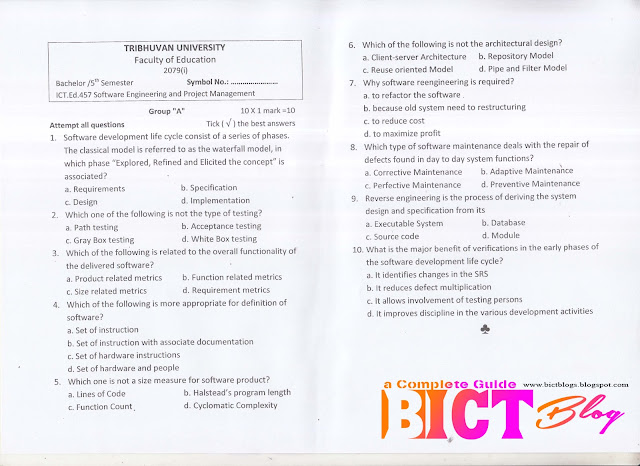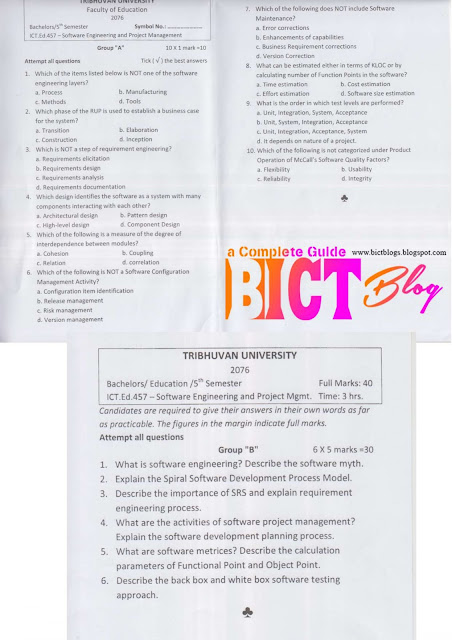
Let's go through each question:
1. The phase "Explored, Refined, and Elicited the concept" in the classical waterfall model is associated with:
b. Specification
2. The type of testing that is not mentioned is:
c. Gray Box testing
3. The metric related to the overall functionality of the delivered software is:
b. Function-related metrics
4. The more appropriate definition of software is:
b. Set of instruction with associate documentation
5. The measure not mentioned as a size measure for a software product is:
c. Function Count
6. The non-architectural design among the options is:
c. Reuse-oriented Model
7. Software reengineering is required:
b. Because the old system needs restructuring
8. The type of software maintenance that deals with the repair of defects found in day-to-day system functions is:
a. Corrective Maintenance
9. Reverse engineering is the process of deriving the system design and specification from its:
c. Source code
10. The major benefit of verifications in the early phases of the software development life cycle is:
d. It improves discipline in the various development activities
5. The measure not mentioned as a size measure for a software product is:
c. Function Count
Sure, let's go through each question:
1. The software process layer related to object-oriented software development is:
c. Methods
2. The option that suits the Manifesto for Agile Software Development is:
d. All of the mentioned
3. The phase of requirement engineering that determines if the system is economically feasible is:
c. Requirements analysis
4. The measure of the degree of interdependence between modules is:
b. Coupling
5. The diagram that is time-oriented is:
c. Sequence
6. The activity that is NOT a Software Configuration Management Activity is:
c. Risk management
7. The correct order in which test levels are performed is:
a. Unit, Integration, System, Acceptance
8. The category of software maintenance that includes the modification of the software to match changes in the ever-changing environment is:
b. Adaptive
9. Effort is measured in terms of:
a. Person Months
10. Software reliability is defined in terms of:
a. Time
Let's go through each question:
1. The phase of the RUP used to establish a business case for the system is:
d. Inception
2. The model not suitable for accommodating any change is:
a. Build & Fix Model
3. The functional requirement among the options is:
d. System Login
4. The use of a Gantt Chart is to:
d. Provide a schedule and track the progress of activities.
5. The depiction of interactions among objects during a certain period of time is:
a. Sequence diagram.
6. The design identifying the software as a system with many components interacting with each other is:
a. Architectural design.
7. The process concerned with analyzing the costs and benefits of proposed changes is:
a. Change management
8. The testing technique requiring preparing test cases to exercise the internal logic of a software module is:
d. White-box testing
9. The testing concerned with the behavior of the whole product as per specified requirements is:
b. System testing
10. The CMM model is designed to:
b. Improve the software process

Let's go through each question:
1. The item NOT one of the software engineering layers is:
b. Manufacturing
2. The phase of the RUP used to establish a business case for the system is:
d. Inception
3. The step NOT part of requirement engineering is:
b. Requirements design
4. The design identifying the software as a system with many components interacting with each other is:
a. Architectural design
5. The measure of the degree of interdependence between modules is:
b. Coupling
6. The activity NOT a Software Configuration Management Activity is:
c. Risk management
7. The option that does NOT include Software Maintenance is:
c. Business Requirement corrections
8. What can be estimated either in terms of KLOC or by calculating the number of Function Points in the software is:
d. Software size estimation
9. The correct order in which test levels are performed is:
a. Unit, Integration, System, Acceptance
10. The factor NOT categorized under Product Operation of McCall's Software Quality Factors is:
d. Integrity






No comments:
Post a Comment